Blog Archives
Gang-gang Cockatoos on a river bank
I’ve been in the Victorian High Country for the last few days. This part of the state of Victoria features gorgeous countryside, steep mountain sides, deep valleys, and wide rivers.
In this lovely setting, I spotted my first Gang-gang Cockatoos. It was a great pleasure and privilege to see a group of these quiet birds feeding and chatting in the early morning. Gang-gangs are on the endangered list, considered to be at high risk of extinction in the wild.
In this video, a female Gang-gang Cockatoo stands on a rock at the edge of the Mitta Mitta River, nibbling at the water weeds. It was early morning, and the light was dim. I’d heard the odd creaky noises that this bird and her companions were making, and went to investigate. To make the video, I stood on a footbridge over the river at Taylor’s Crossing Campground.
I love the noises that these birds make. A mix of creaks and growls. It was the sound that led me to investigate, like a cross between the call of a raven and the squawk of a cockatoo. You can hear some of the bird’s soft creaks at the start of the above video.
The name “gang-gang” comes from the Wiradjuri language, and maybe from other Aboriginal Australian languages too. It’s most likely an onomatopoeic word, echoing the noises that the birds make.
It also interesting to see a cockatoo eating a water weed. She chewed through the entire long strand, consuming the whole thing with evident enjoyment.
There were four Gang-gangs at the river: two females, an adult male, and a juvenile male. My photos are a bit fuzzy, due to the early morning dimness.
Here’s the adult male, with his bright red head and crest:

The next photo shows an immature male. The red on his head and crest is just starting to come in. (Ignore the red leaf at the end of the bird’s tail):
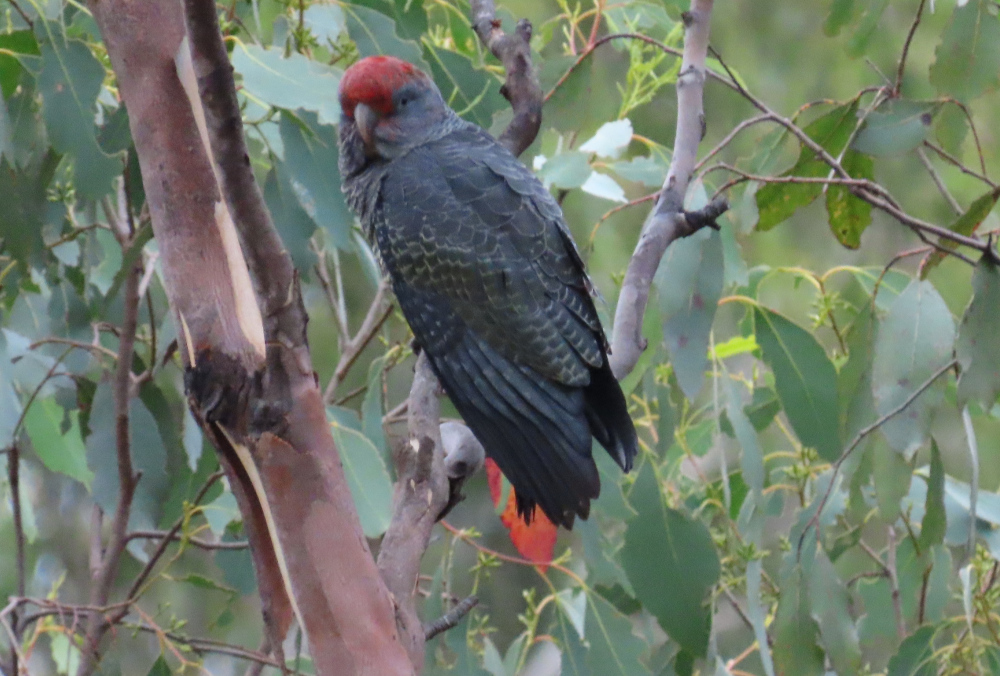
Here’s a photo of the female down on the river bank:
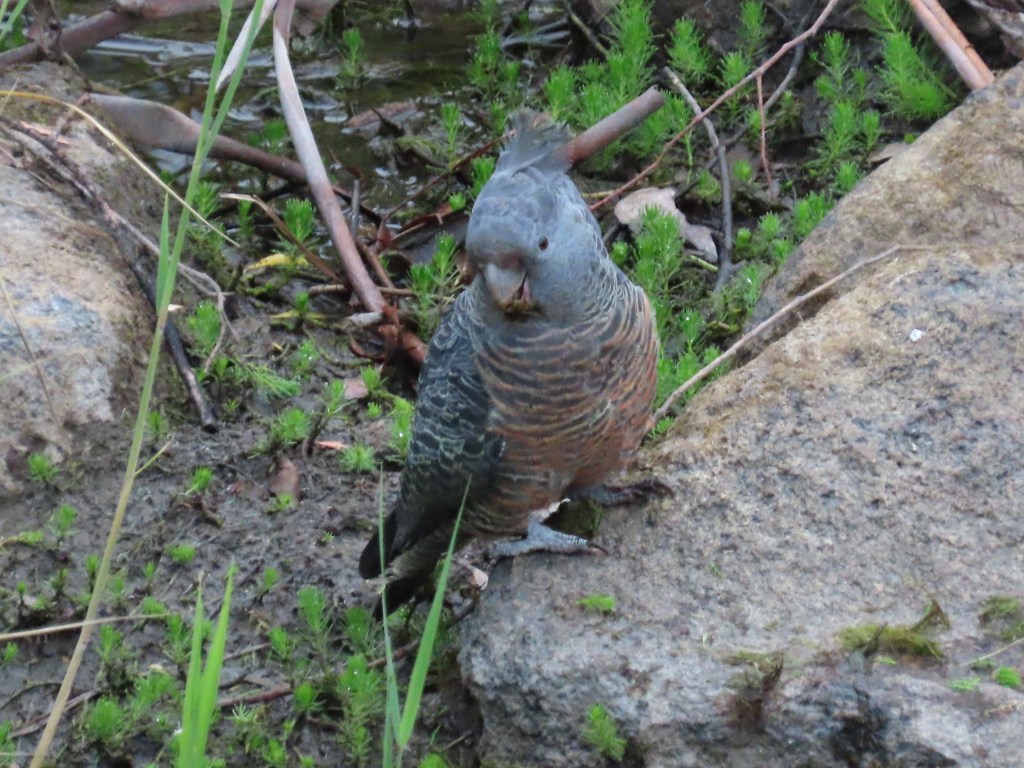
Her wispy crest is a soft grey, a bit like a feather duster:

Common name: Gang-gang Cockatoo
Scientific name: Callocephalon fimbriatum
Approximate length: 33-36 cm
Date spotted: 25 February 2025 (summer)
Location: Taylors Crossing Campground, Mitta Mitta River, Victorian High Country, Australia: 36°49’33.7″S 147°39’40.6″E
Termites and kookaburras
Termites are very active in our area of the world at the moment: the east coast of Australia just north of Sydney. When walking along a road that passes through a park area, it’s common to see low mud tunnels crossing the road. Termites build these tunnels to shelter in when they’re on their travels. Recently, I’ve also seen long trains of termites venturing out without any cover at all.
Here’s a stream of termites crossing the road. They’ve even built themselves a junction so that they can head off in different directions:
Termites’ mud tunnels often go up the outside of a tree:
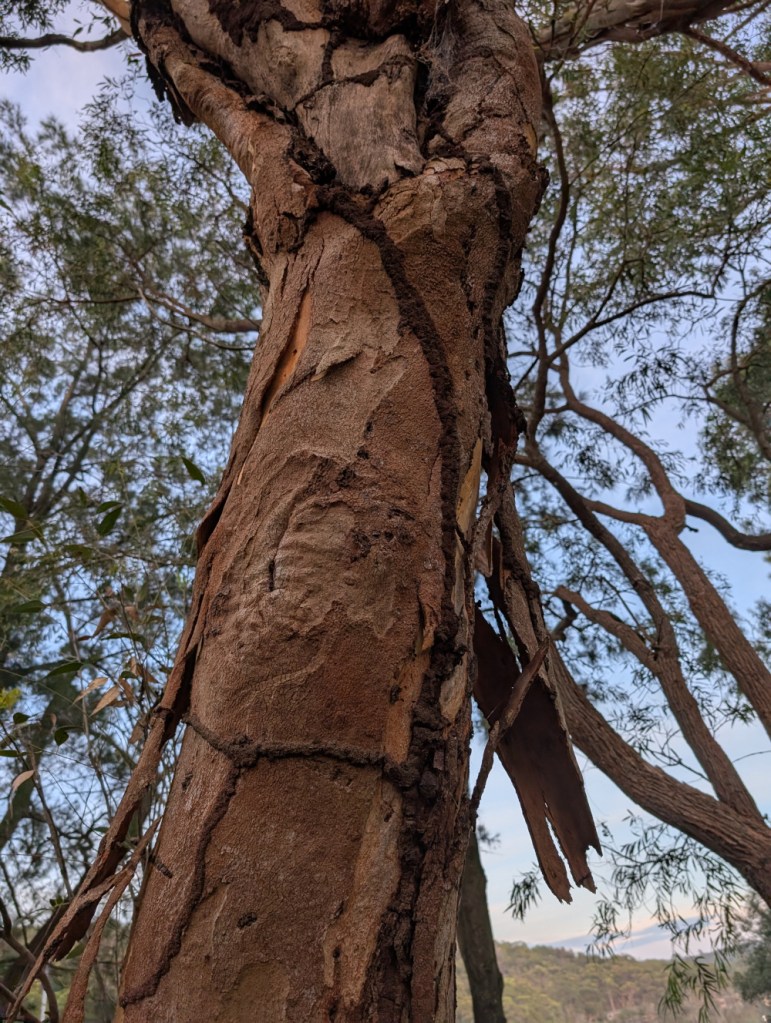
The termites in this part of Australia build their nests as large mud mounds, stuck high up in a tree:

Termite nests make a handy home for monitor lizards, kookaburras, kingfishers, and other creatures. In an earlier post, I showed pictures of a termite nest that had been adopted by kookaburras as a home for their young family: Baby kookaburras out of their nest.
In the next video, two young kookaburras attack the side of a termite nest, slowly digging a hole in the nest. They’re probably thinking ahead to the next breeding season, when such a home will come in useful:
In the video, you can hear the two kookaburras chattering, and other kookaburras giving the full laughing cackle in the background. There are also cicadas singing, and a butcherbird calls at one time too.
Common name: Laughing Kookaburra
Scientific name: Dacelo novaeguineae
Approximate length: 47 cm
Date spotted: 13 January 2025 (summer)
Location: Manly Dam near Sydney, New South Wales, Australia
Baby kookaburras out of nest
For the past month, I’ve been watching a termite nest that housed two Laughing Kookaburra chicks. The kookaburra parents had set up house in an old termite nest in a dead tree. The sound of the chicks crooning drew me to the tree on November 21st. The chicks were still very young, and it wasn’t possible to see them. But after waiting around a while, I did see the parents bringing food to the nest:
A month later, on December 20th, the chicks were right at the opening of the nest, peering out at the world. This photo shows one of the babies — you can see one eye clearly on the right, then the beak and white bib and the other eye on the left:

Here’s a view of the termite nest at the top of a dead tree. The nest projects from the top the right of the dead trunk, nicely protected by the branches of a living tree:
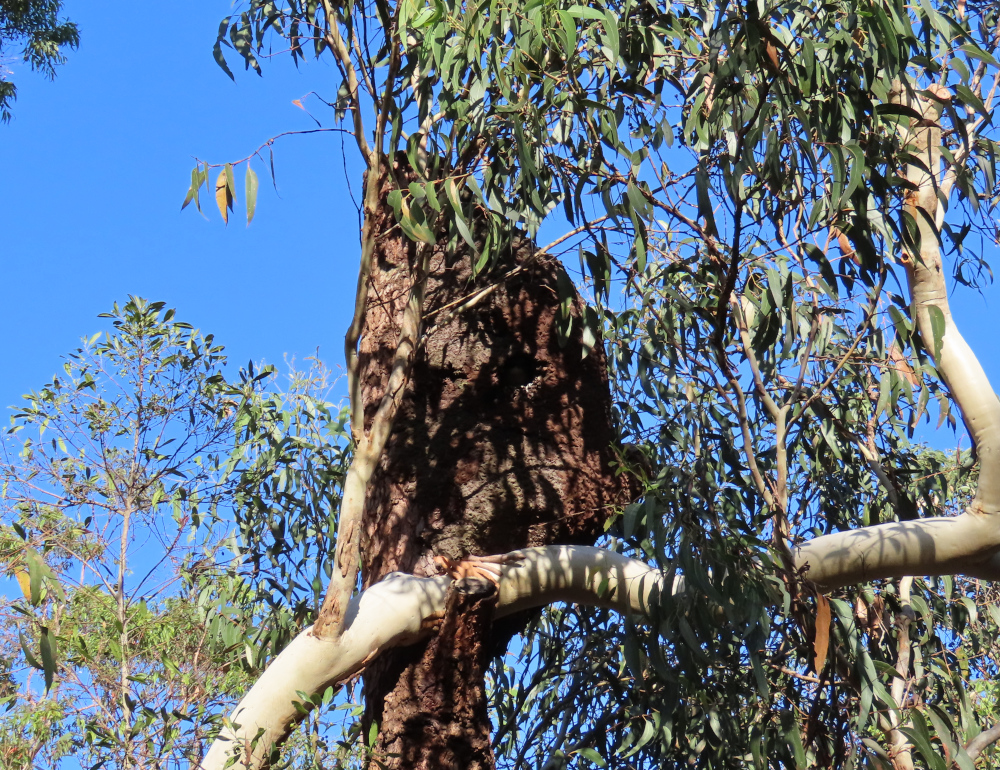
Here’s one of the parents with a morsel of food — a winged insect of some kind:

By my next visit, on December 23rd, the nest was empty. Both babies were out and about, calling and being fed by the adult birds.
One of the babies was on the ground when I got there, but soon managed to fly up onto a tree branch. The parents were nearby and attentive:
The youngsters are a bit smaller than the adults, and more fluffy. Their feathers aren’t yet fully developed, especially on the head and wings, and the tails are noticeably shorter.
The other youngster was on a nearby branch, also crooning:
This photo shows the youngster’s short tail:
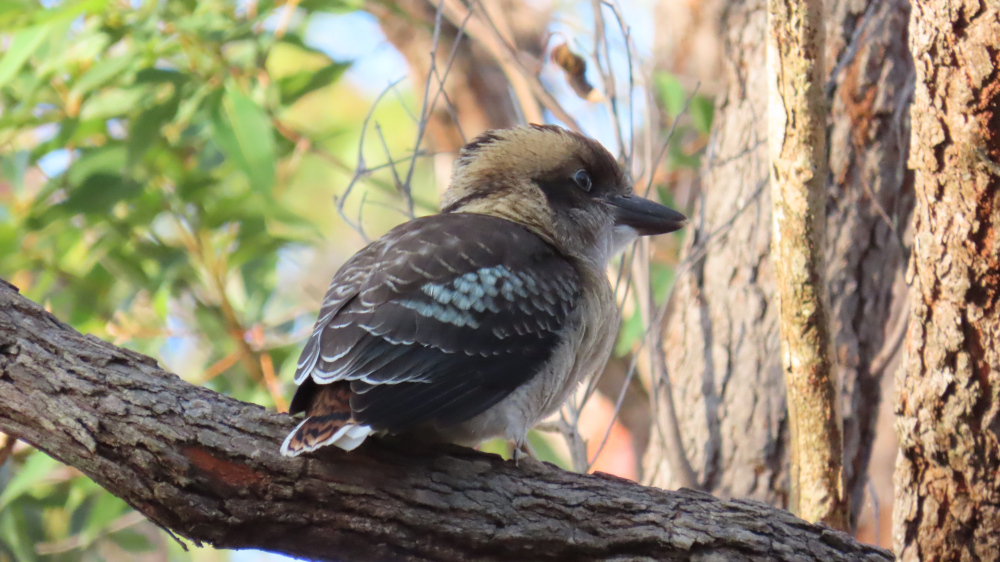
To close off, here’s the same youngster from another angle:
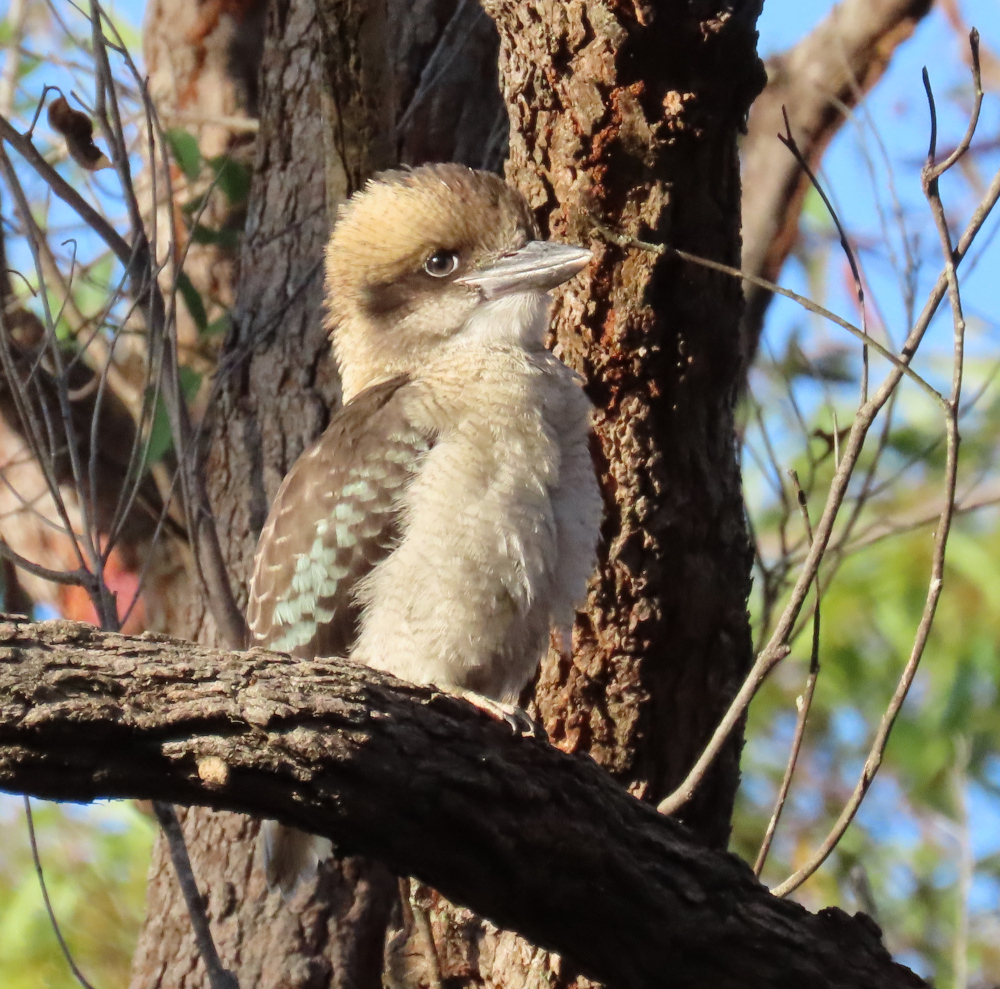
Common name: Laughing Kookaburra
Scientific name: Dacelo novaeguineae
Approximate length (adult): 47 cm
Date spotted: 21 November to 23 December 2024 (summer)
Location: Manly Dam near Sydney, New South Wales, Australia
Story of two nesting Black Swans: Part 1
This is part 1 of a story about a pair of nesting Black Swans. At this point, I’m concerned about the state of the swans’ eggs. I don’t know what part 2 will hold, but I do hope for a happy ending.
These two swans have been sitting on their nest since late August. I first saw them sitting on 23 August, and a park ranger told me that they’d been sitting for at least a few days by then. It’s now 9 December. That’s more than 15 weeks — more than 105 days.
The eggs of Black Swans usually hatch after 39-45 days.
This photo is from the first time that I saw the nest, on 23 August:
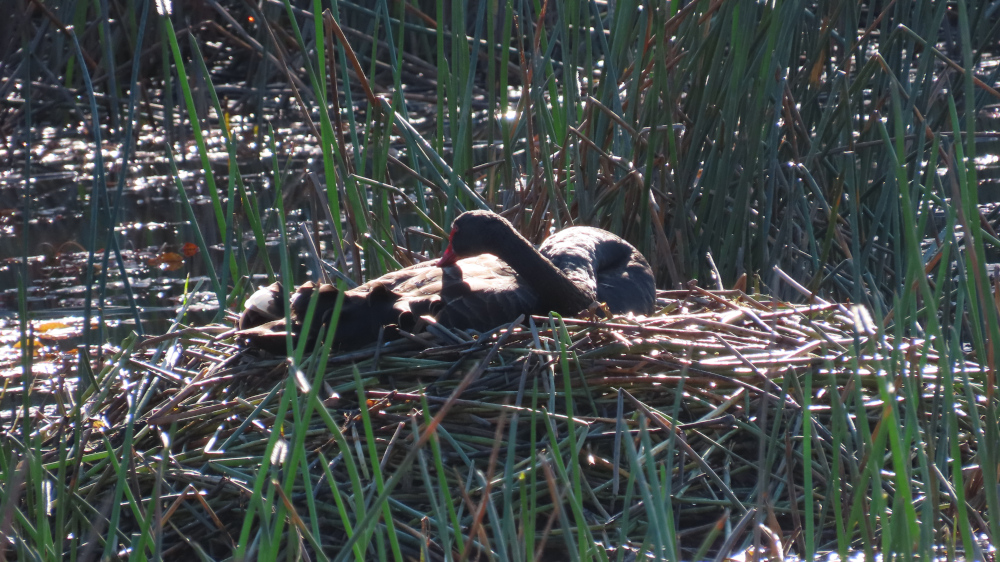
(Photo taken on 23 August 2024)
The swan’s nest is a large pile of reeds, positioned in shallow water in the middle of a large reed bed. It’s quite a distance from the shore on both sides, and well screened from entrance on the water too. From the shore, it’s not possible to see into the nest. I’m assuming there are eggs, because the swans are very diligent about sitting on the nest and occasionally it looks as if they gently prod the eggs with their beaks.
Here’s another photo from the early days:
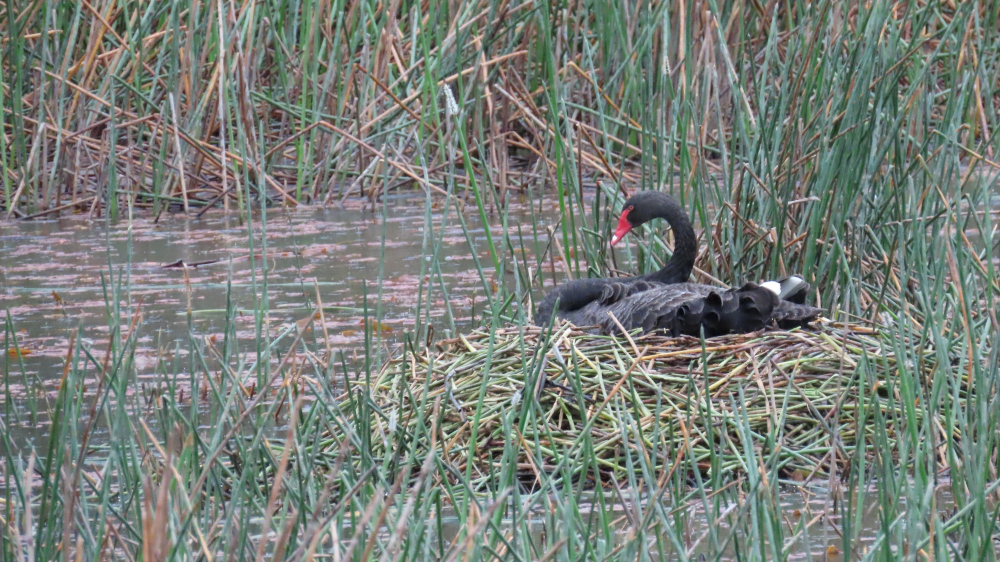
(Photo taken on 24 August 2024)
The setting is tranquil and pretty:
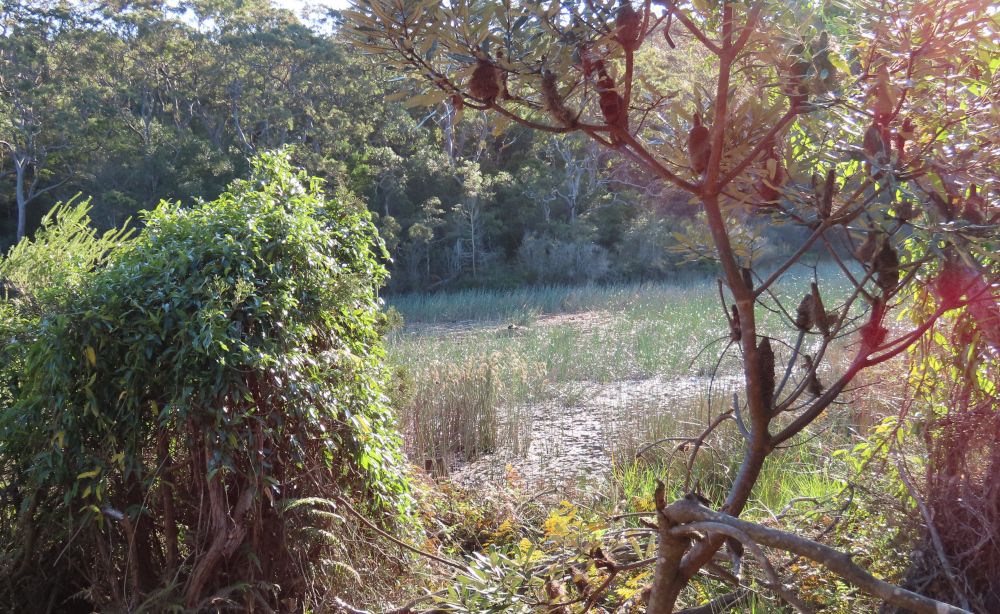
(Photo taken on 2 September 2024)
The nest is near a popular bush walking path, and I’ve walked past it every few days. When the first period of 45 days went by with no cygnets appearing, I thought maybe the parents had decided that their first batch of eggs was infertile and had started again.
But now the second period of 45 days is well and truly passed, and I’m worried.
Both the male and the female swan are still actively looking after the nest. I’ve seen each of them sitting on the nest alone, and occasionally both of them tending the nest together. The nest is never without one of the swans sitting or standing over it.

(Photo taken on 3 October 2024)
The male and female take turns to sit on the nest. The next video shows the changing of the guard. One bird has been sitting all night, the other has arrived for the morning shift. One of the birds grooms itself, and they both do a bit of nest maintenance. If you listen carefully, you can hear the swans’ soft hoots as they chat to each other:
(Video taken on 1 October 2024)
Every now and then, the swans spend quite some time and energy clearing the reeds around the nest and building up the nest:

(Photo taken on 3 October 2024)
Despite the nest’s seclusion, plenty of ducks, coots, and moorhens swim around the nest, keeping the swans company. Every now and then other visitors appear, like this kookaburra:

(Photo taken on 4 October 2024)
And this Eastern Water Dragon:

(Photo taken on 17 November 2024)
On 1 October, a beautiful light-coloured Grey Goshawk made an appearance near the nest, and was chased away by currawongs and cockatoos:

(Photo taken on 1 October 2024. I wrote another post about the goshawk.)
Here’s a nice video of one of the swans seating itself carefully on the nest:
(Video taken on 28 October 2024)
In more recent days, the site of the nest has become less tranquil. Cicadas have crept up from the earth to celebrate the summer full blast, as only cicadas can do. Sulphur-crested Cockatoos collect in the tree tops, high above the nest. The cockatoos squawk and yell, outdoing even the cicadas. It’s a very noisy environment for a nest, but at least it gives the parent swans some company. At this stage, they’d been sitting on the nest for more than 100 days:
(Video taken on 29 November 2024)
When it’s their turn for a break from sitting on the nest, one of the adults heads off to another part of the dam to stretch and feed. Here, a pelican keeps the off-duty swan company:
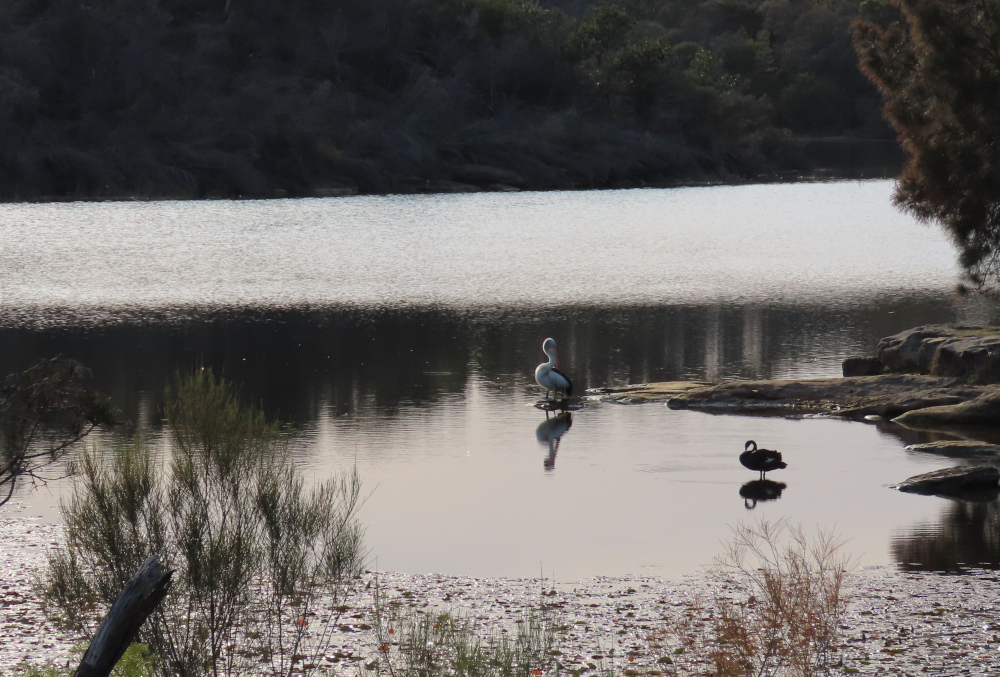
(Photo taken on 9 September 2024)
It’s good to stretch and preen:
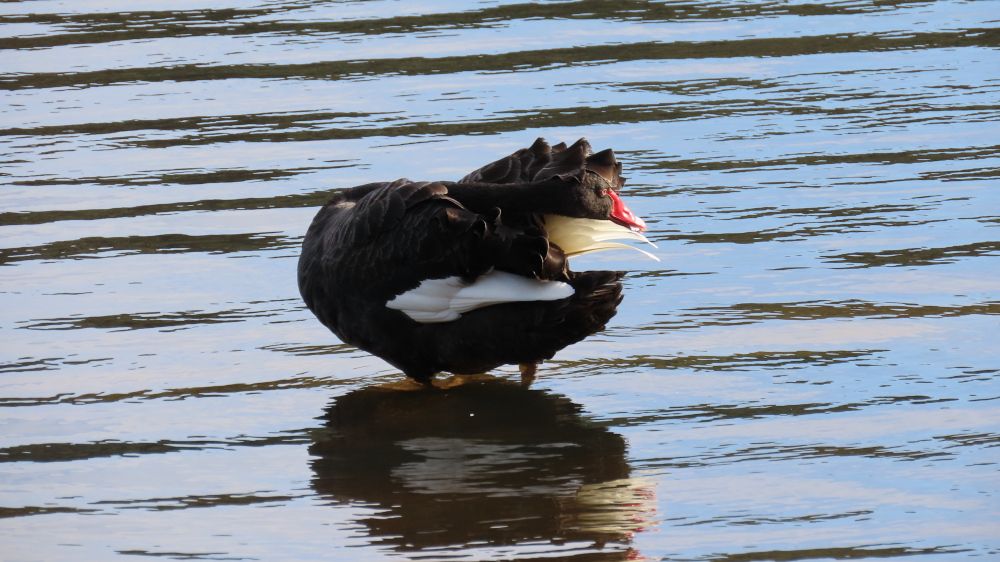
(Photo taken on 9 September 2024)
In the next video, one of the swans comes in close to shore for a good stretch. Eastern Koel cuckoos and cicadas dominate the sound waves. On a rock nearby, an Eastern Water Dragon looks on:
(Video taken on 21 November 2024)
In the next video, a Great Cormorant watches on as the swan preens and fluffs its wings. Cockatoos, Eastern Koels, and Channel-billed cuckoos call in the distance:
(Video taken on 29 November 2024)
As I write this post, December has arrived and the bush has a surfeit of insects. It’s very noisy at the swans’ nest. Two kookaburras dropped by and chatted a bit. Moths flap past, cicadas shriek, and a dead heat beats down on the nest:
(Video taken on 6 December 2024)
The last time I visited the nest was yesterday, 8 December. The swans were still sitting. Two kookaburras dropped by again and the cicadas were still very noisy.
I’ll keep a look out to see what’s happening at the nest next time I pass. I do hope to see the two swans relieved of their nesting duties. It would be wonderful to see some little ones to reward their amazing dedication. Even if there are no cygnets, though, it’d be good to see the adults roaming free again, ready for another go at raising a family next year.

(Photo taken on 8 December 2024)
Good luck, patient swans!
Update on 10 April 2025: Black Swans abandon nest after 8 months (part 2 of story).
Common name: Black Swan
Scientific name: Cygnus atratus
Approximate length: 120 cm
Date spotted: 23 August through to 8 December, 2024 (late winter, through spring, going into early summer)
Approximate location: Manly Dam Park, New South Wales, Australia
White-winged Choughs dust-bathing and feeding youngsters
A few days ago, I spent some time at Coolendel Campground in New South Wales. A group of White-winged Choughs strutted around the area, picking up grubs, taking dust baths, and chattering from the trees.
In this video, the adults are feeding grubs to two noisy youngsters.
White-winged Choughs look quite similar to currawongs and crows, but they belong to a different family. Along with Apostlebirds, they’re the only members of the Corcoracidae family. And like Apostlebirds, White-winged Choughs build nests by forming a bowl out of mud.
At first sight, these birds seem entirely black, but when they open their wings you notice the white wing flares. Adults have striking red eyes.
Here, two of them take a dust bath. It’s interesting to see that they pick up beakfuls of dust and dump it on their feathers, rather than lying in the dust:
Common name: White-winged Chough
Scientific name: Corcorax melanorhamphos
Length: 43-47 cm
Date spotted: 1 November 2024 (spring)
Location: Coolendel Campground, Buangla, New South Wales, Australia: 34°50’39.3″S 150°25’18.5″E
Bird on a wire – Eastern Rosella
Eastern Rosellas are medium-sized parrots, found on the east coast of Australia. We’re lucky enough to be visited regularly by a pair of them. I don’t know if it’s the same two birds each time, or if our phone line is somehow part of the flight lines for a family of birds.
In this video, the male Eastern Rosella struts along a phone line, spiffy in his breeding colours. Alas, the background sound is noisy, but you can just hear the bird chirping as he does his little hello dance:
The next picture is somewhat whimsical. It’s what my camera made up when the bird flew off. I love the colours and motion in this picture, even if the bird’s head is off camera:

The female glowed in the sunlight:

The male’s colours are brighter, with the divisions between the coloured sections more clearly defined. Deep blue and black scallops outline the wings, while the rest of the bird is yellow and black, and red and white:
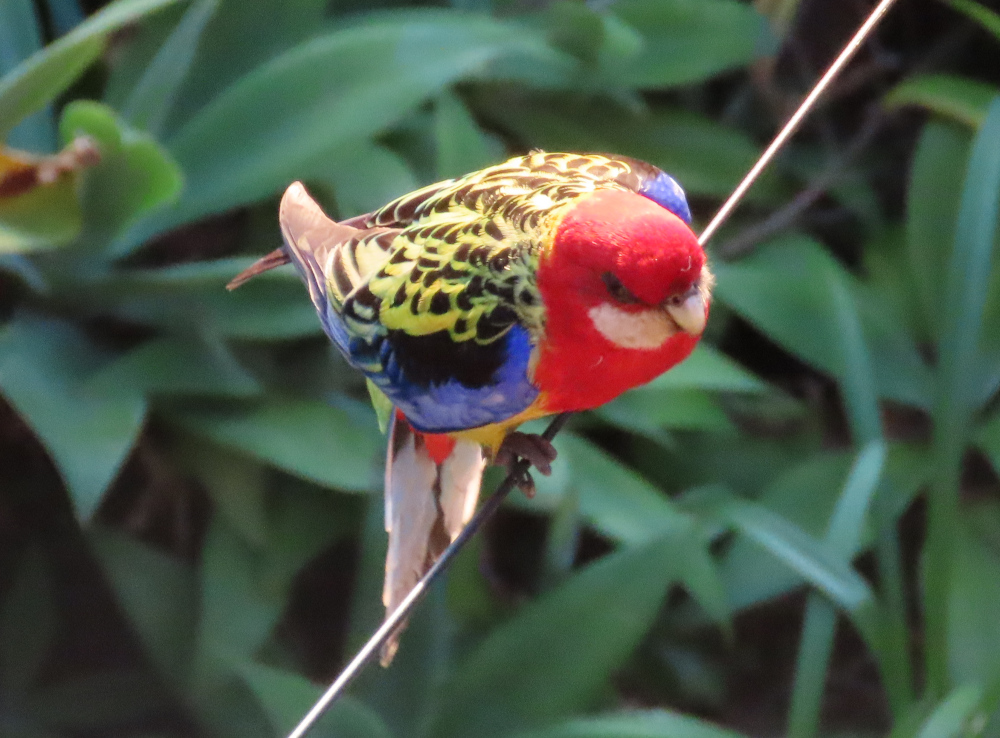
He knows he’s gorgeous!
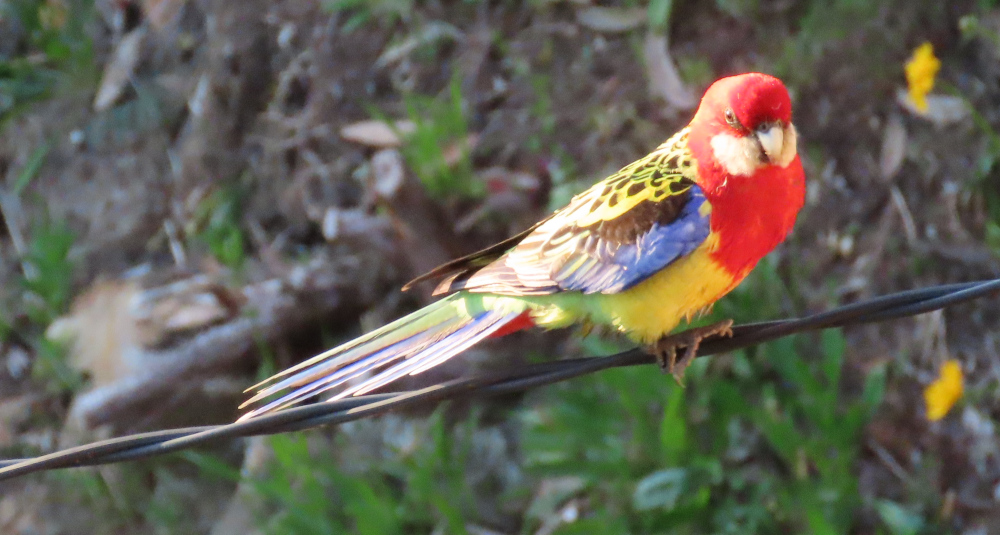
Common name: Eastern Rosella
Scientific name: Platycercus eximius
Approximate length: 30 cm
Date spotted: 28 October 2024 (spring)
Location: Allambie Heights, NSW, Australia
What does a Darter sound like? Plus random turtles.
Darters are large water birds, a bit like cormorants. They make a weird cackling sound, a bit like a sardonic duck. And they only do it every now and then, for a short time, so you have to just be there with your camera ready if you want to record the call.
I was lucky to be looking at a kingfisher through the camera lens when a darter started cackling nearby. Here’s what I got on camera — the darter call is right at the start of the video. Also, when watching the video I noticed there are a couple of turtles on a log at bottom left of the shot, visible just as the camera starts zooming out.
Here’s the darter with its beak open. I’m not sure if it was thinking of cackling again or if something was tickling its throat. It is, after all, rather a long throat:
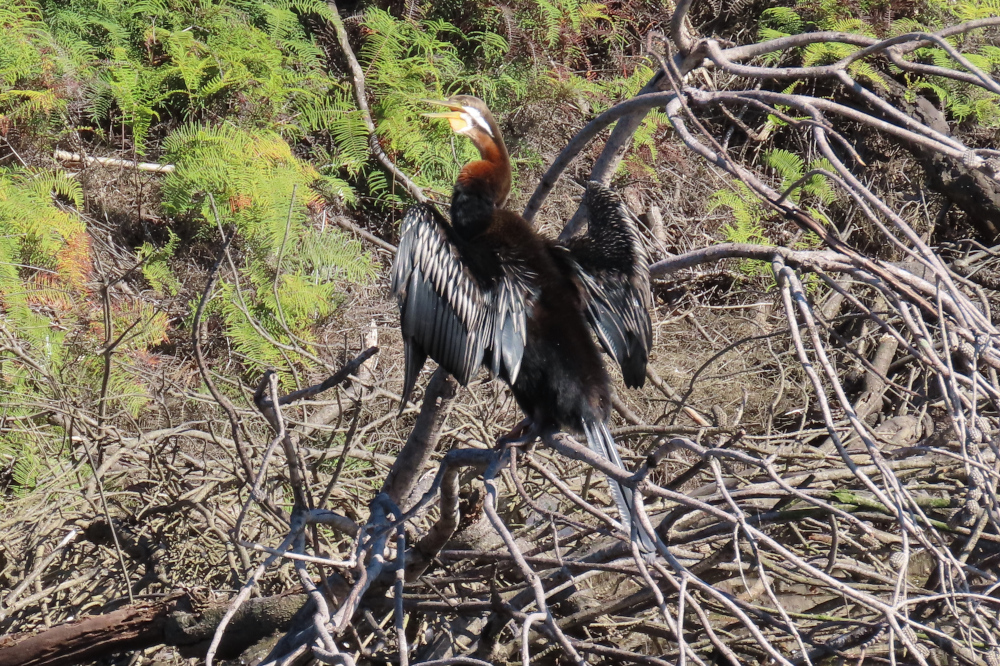
Here’s a pic showing the turtles on the log at bottom left. I didn’t know they were there until I saw the photos on a big screen. There are at least two turtles, one behind the other, and possibly a third below them:

This bird is a male, with its black neck and red throat.
Common name: Darter
Scientific name: Anhinga melanogaster
Approximate length: 90 cm; wing span: 1.2 m
Date spotted: 10 October 2024 (spring)
Location: Manly Dam Reserve, New South Wales, Australia: 33°46’34.7″S 151°14’48.9″E
Did the big scary lizard make the Mudlarks abandon their nest?
For a few weeks now, I’ve been watching a pair of Mudlarks building their nest. In fact, they’ve built two nests. The first one looked good and solid from my vantage point, far away and down at ground level. But a couple of days after they’d finished it, they abandoned it and started a new one higher up in the same tree.
Mudlarks, also called Magpie-larks or Peewees, build neat round nests that are basically bowls made of mud. This video shows a male Mudlark collecting mud and reeds at the water’s edge. When he has a good collection, he flies off towards the nest that he and his mate are constructing. As the bird flies, a couple of Kookaburras start cackling, and one of the Mudlarks gives its distinctive call: “pee-wee pee-wee pee-wee”.
Here’s the male Mudlark on mud collection duty:

The next video shows the first nest under construction. The bird prods and pushes mud into the walls of the nest, then sits flat and wiggles its tail end to shape the nest.
As well as building walls, nest construction also involves sitting on the nest and wiggling back and forth to get the shape right:

The nest was looking good, I thought. But several days later, a decision is made. The birds abandon their first attempt and start a new nest, higher up in the same tree:
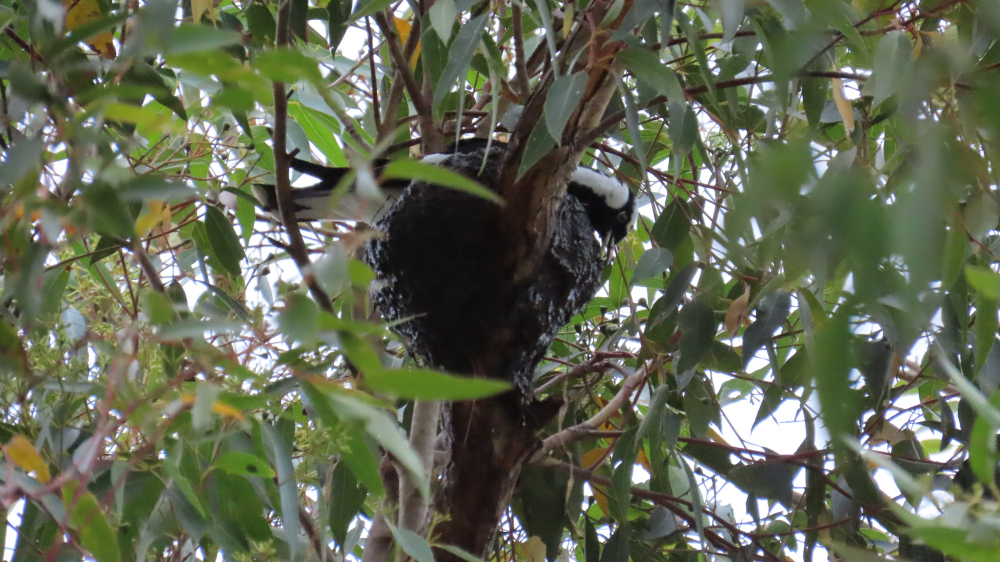
They’ve chosen a lovely spot, at the edge of Manly Dam. The next video shows one of the birds building the second nest. The second bird arrives with a beak-ful of mud, and takes over construction. The video then zooms out and in again to show the first nest on a lower branch, then zooms out further to show the dam and some of the neighbours (a Little Black Cormorant and a Great Egret).
Aside from the occasional noisy cockatoo, the neighbours are quiet for the most part — like this Great Egret:

And a few water dragons:

But the park does get quite busy over the weekend. Families hold picnics nearby, and children paddle in canoes. Perhaps the birds moved higher to avoid the weekend disturbance.
Perhaps the first nest didn’t meet quality assurance checks. Or perhaps the two parents-to-be spotted the large, scary intruder in the neighbourhood: a Lace Monitor lizard. I took this video of the lizard prowling around the tree where both nests are. Lace Monitors eat eggs and baby birds, and are very good at climbing trees. The Mudlarks’ second nest is higher in the tree and on thinner branches, which would make it much more difficult for the lizard to reach.
Lace Monitors are the second-largest lizards in Australia. They measure 1.5 to 2 metres long — longer than I am tall, and their hands are as big as mine! Here’s a close-up of the Lace Monitor on the move:
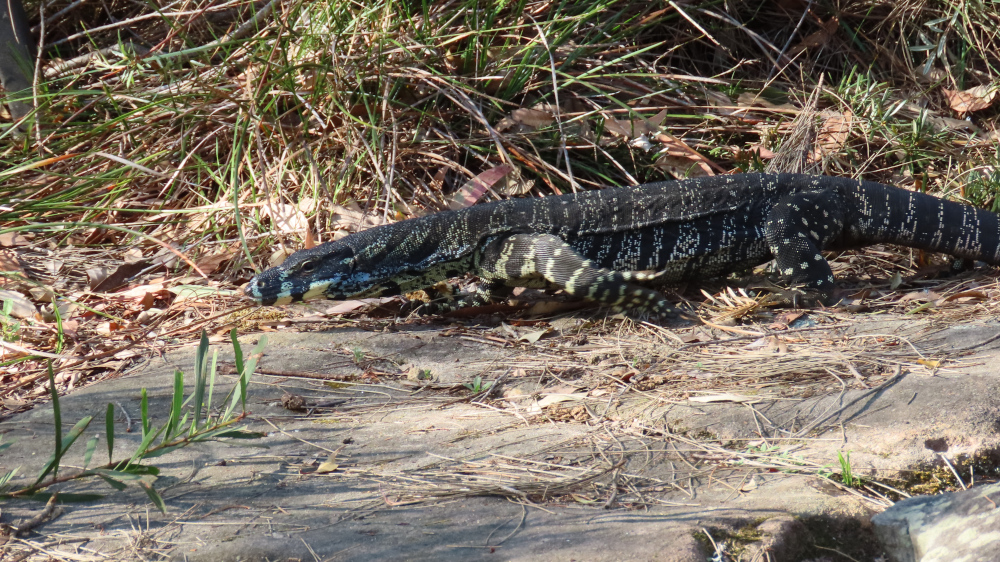
When I got too close with my camera, the lizard crouched down and went into stealth mode:

The Mudlarks are still sitting happily on their new nest. Here’s the male:

And here’s the female:
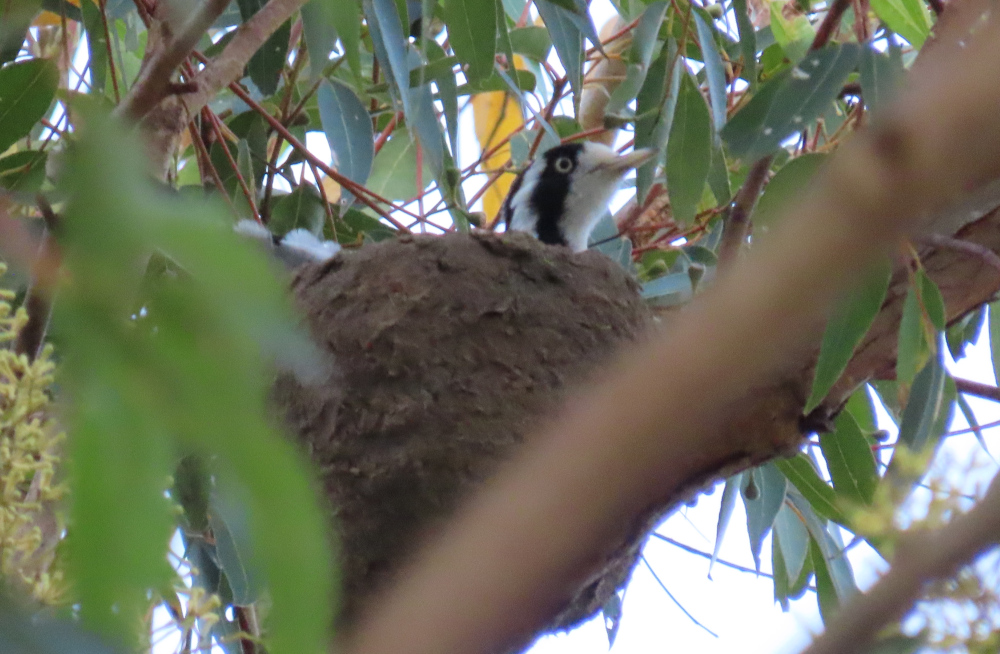
Good luck to them and their new family!
Common name: Magpie-lark, also called a Peewee or a Mudlark
Scientific name: Grallina cyanoleuca
Approximate length: 30 cm
Date spotted: August to September 2024 (summer)
Location: Manly Dam National Park, New South Wales, Australia
Call of the Sacred Kingfisher
Ever wondered what a kingfisher sounds like? Well, you’ll know after watching this video, for a Sacred Kingfisher anyway. The call is a series of chirps, all on more or less the same note. Not very exciting really, for such a pretty bird! You hear them mostly around breeding time, when the calls can be quite insistent.
At the start of the video, you see and hear the kingfisher calling. The camera then zooms out to show the surroundings, including a Great Egret, a Darter, and a Coot. The scene is set at Manly Dam in Sydney’s Northern Beaches.
Set the video settings to HD for best results:
Despite their name, these kingfishers don’t often eat fish! Instead, they prey on small reptiles and large insects, and occasional crustaceans from the water’s edge.
Common name: Sacred Kingfisher
Scientific name: Todiramphus sanctus
Length: 20-23 cm
Date spotted: 8 September 2024 (spring)
Location: Manly Dam Park, New South Wales, Australia: 3°46’31.2″S 151°14’46.6″E
Currawong crazy hour
An excited group of currawongs made our backyard the centre of their activity yesterday afternoon. The commotion lasted at least half an hour. Birds dashed back and forth, calling and flying noisily past each other. Parents of young children will sympathise with the term “crazy hour”, sometimes called the “witching hour”, in late afternoon — it seems to apply to currawongs too!
Common name: Pied Currawong
Scientific name: Strepera graculina
Approximate length: 45 cm
Date spotted: 31 August 2024 (end of winter)
Location: Allambie Heights, north of Sydney, New South Wales, Australia








